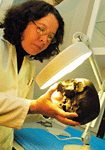
Posted on 02/22/2003 9:06:38 AM PST by blam
VINTAGE SKULLS

Researcher Silvia Gonzalez examines a 13,000-year-old skull. (Liverpool John Moores University)
The oldest human remains found in the Americas were recently "discovered" in the storeroom of Mexico's National Museum of Anthropology. Found in central Mexico in 1959, the five skulls were radiocarbon dated by a team of researchers from the United Kingdom and Mexico and found to be 13,000 years old. They pre-date the Clovis culture by a couple thousand years, adding to the growing evidence against the Clovis-first model for the first peopling of the Americas.
Of additional significance is the shape of the skulls, which are described as long and narrow, very unlike those of modern Native Americans.
Joseph Powell, a physical anthropologist at the University of New Mexico, cautions that other explanations for the skull shape differences must be considered before jumping to conclusions about origins. "Natural selection or some other microevolutionary forces may play a role. People change when their diets change. This happened in China, for example. Ancient Chinese don't really look much like modern Chinese from the same area. It's a worldwide phenomena and it may be related to the changes at the end of the Ice Age."
Paleoindian specialist Kenneth Tankersley believes archaeology is only beginning to scratch the surface of the debate. "Variation in the languages and DNA of American Indians not only suggests there were multiple migrations from a number of different homelands, but they imply that the first wave of people arrived in the Americas more than 30,000 years ago. This suggests archaeologists should be looking in older geological strata."
DNA evidence might be the best way to know where the first Americans came from and how or why they changed over time. The researchers have planned DNA tests, though successful extraction from remains this old is challenging.--COLLEEN P. POPSON

"Alas, poor Yorick...."
<|:)~
In 1959, the partial skeletal remains of an ancient woman estimated to be 10,000 years old were unearthed in Arlington Springs on Santa Rosa Island, one of the eight Channel Islands off the southern California coast. They were discovered by Phil C. Orr, curator of anthropology and natural history at the Santa Barbara Museum of Natural History. The remains of the so-called Arlington Springs woman were recently reanalyzed by the latest radiocarbon dating techniques and were found to be approximately 13,000 years old. The new date makes her remains older than any other known human skeleton found so far in North America.
The discovery challenges the popular belief that the first colonists to North America arrived at the end of the last ice age about 11,500 years ago by crossing a Bering land bridge that connected Siberia to Alaska and northwestern Canada. The earlier date and the location of the woman's remains on the island adds weight to an alternative theory that some early settlers may have constructed boats and migrated from Asia by sailing down the Pacific coast.(Just because they came from Asia does not mean that they were Orientals)
The Arlington Springs woman lived during the end of the Pleistocene era when large herds of bison and woolly mammoths roamed the grassy plains and other extinct native American animals such as camels, horses, and saber-toothed cats were still around.
The remains of Pleistocene-era animals have been discovered on Santa Rosa Island where the Arlington Springs woman was found. In 1994, the world's most complete skeleton of a pygmy mammoth, a dwarf species, was also excavated here.
Dr. Usher ... calling Dr. Usher .....
Mormon?
You mean Bishop Usser who dated the world at 4004 years old?
Not exactly. I believed he dated the Creation to 4004 BC, which would make the world a little over 6000 years old.
Not exactly. I believed he dated the Creation to 4004 BC, which would make the world a little over 6000 years old.

You are correct. I couldn't remember if it was 'BC' or not. I had expected to be 'called' on the date regardless. Thanks.
Sorry. Now can you just get over it? It was 10,000 years ago.
Many Indians don't much like the term "native American" anyway.
American is just fine. Wyandot if you want to be specific.
Disclaimer: Opinions posted on Free Republic are those of the individual posters and do not necessarily represent the opinion of Free Republic or its management. All materials posted herein are protected by copyright law and the exemption for fair use of copyrighted works.